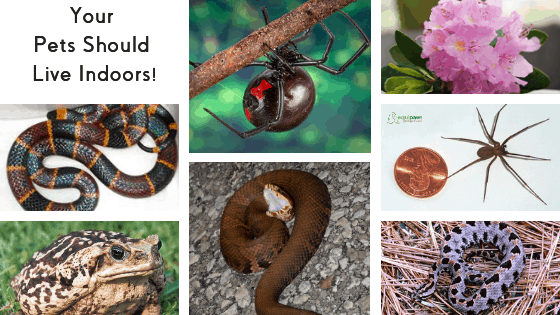Why your pets should live indoors
Whether our pets should live indoors or outdoors is usually a very controversial topic. There is the argument that dogs and cats were born wild and therefore should remain outdoors in their natural world. However, the dogs and cats we bring into our lives now have lost most of what made them wild originally. Although their natural instincts are still present they are muffled by their need and desire for human interaction.
Even the pets that shy away from human interaction are still influenced by our presence, and the connection affects their ability to survive in the wild as they may have thousands of years ago. In the world we live in today and with how dependent our dogs and cats have become, it is no longer safe to keep our beloved pets outdoors. If you aren’t convinced here are some major reasons to leave your pets inside.
Weather
Even with expert opinions, many weather conditions remain unpredictable and make outdoor living for most pets undesirable. Drastically high or low temperatures can be fatal to even the most tolerant pets. Dogs and cats cannot sweat, so cooling down in hot climates is not done as easily as it is for humans and the risk of fatal heat stroke is all too real. In cooler climates, once temperatures drop below freezing, outdoor pets risk frostbite, which, if the outcome is not fatal, can lead to loss of extremities. Storms are also a major concern, especially here in the Sunshine State. In Florida, more people are killed by lightning each year than by sharks! A pet getting struck by lightning or swept away in the high winds or flooding of a hurricane becomes a harsh reality.
People
In a highly-populated world and in the fast-paced society most of us live in, animals are at risk to harm from humans. The harm is typically unintentional; however, the reality is we live in a world revolved around humans. There are more cars on the road than ever and animals are often subject to hit and runs. More often than not they are left there injured, helpless, and alone.
Although few, there are instances in which people intentionally harm animals. As animal lovers, it’s hard to imagine there are people out there who dislike animals, but leaving our pets outdoors leaves them victim to acts of animal cruelty. Unfortunately, we cannot change people’s behaviors, but we can protect our pets from unnecessary pain.
Herbicides, Insecticides, and Pesticides
If used properly most herbicides, insecticides, and pesticides should not be toxic to animals. However, the constant pursuit of getting the perfect lawn or garden often leaves the person using such products oblivious to the harm they are causing to those around them. A wandering, curious pet may stumble across an unattended product or they may be exposed secondhand to a product that was spray on an area they wander upon. Most products ingested by pets can lead to severe abdominal pain, vomiting, diarrhea, and sometimes death.
Poisonous Plants
Sometimes the products we spray are not the most toxic thing about the plants in our yards. There are a number of ornamental plants that are toxic to pets that people don’t know about. Some common, poisonous plants include, but are not limited to, azaleas, daffodils, tulips, nightshade, lantana, and sago palm. Without the privilege of having hands, pets are left to explore with their mouths. Ingestion of these plants can lead to typical symptoms such as vomiting and diarrhea, but more severe cases can lead to coma and death within days.
Rodenticides
Without question, direct ingestion of a rodenticide is extremely toxic to pets, but the secondhand effect can be just as dangerous! Using rodenticides is a quick fix to a nasty problem and there is no doubt that it does the job eliminating rodents from an unwanted area. The issue is what happens to these rats and mice once they are eliminated. If a pet stumbles across a dead rodent, more often than not they will eat the easy prey item. Even though the rodenticide is not directly ingested it still remains highly toxic to animals and often leads to death of our furry friends.
Dangerous Animals
Another thing people overlook when they choose to let their pets roam freely outdoors is that they are subject to injury from our wildlife. Pets are curious creatures and their connection to the human world has left them fearless of many predators out there. Often people think the solution to this problem is to eliminate the harmful wildlife in the immediate area, but let this be a reminder that it is ILLEGAL to cause any intentional harm to wildlife! If someone is caught harming wildlife they can face jail time and a hefty fine!
- Venomous spiders and snakes should be a concern to pet owners who opt to leave their pets outdoors. There are two venomous spiders (black widow and brown recluse) and six venomous snakes of concern in Florida (. If both a snake and spider bite go untreated they can lead to a slow, painful death.
- Bufo toads, commonly known as Cane toads, are also a species of concern. The poison, a scared toad releases, can be deadly to a pet if too much is swallowed. Lives can be saved if a pet owner immediately rinses the poison out of their mouth and rushes them to the vet. However, if a pet is outside and left unattended, a poisoning can go undetected and a life could be lost. Learn more about Bufo Toads.
- Although uncommon, outdoor pets can become prey to larger wild predators. For example, here in Florida, cats and small dogs can become a food item for an opportunistic eagle, panther, coyote, alligator, etc. These instances are rare, however if the opportunity presents itself it is a possibility. They are just doing what they need to do to survive, so it is the owner at fault and not the animal taking advantage of the situation.
Dangers to Wildlife
A matter that is often overlooked is the negative influence outdoor pets can have on our native wildlife. According to a 2010 study conducted by the University of Nebraska, it’s estimated that cats are responsible for over 4 billion animal deaths every year. A large portion of their kills are targeted towards native wildlife, such as birds, squirrels, rabbits, lizards, snakes, and frogs. Many people don’t want to admit their cats could do such a thing, but as mentioned before some of their natural instincts are still present.
Cats aren’t the only culprits to killing wildlife. Dogs have also been known for their fair share of killings. Without the proper supervision, these free-roaming pets are free to do as they please and could be responsible for decrease in native wildlife populations.
Keep Your Pets Safe- Keep Them Indoors
When we make the decision to let a pet into our lives, we make the decision to let them into our family. If we would do anything to keep our family members safe, why shouldn’t the same be done for our pets? We encourage all pet owners to take time out of their busy lives to give their furry friends what they are craving; quality time outdoors with the owner they love, a roof over their heads, and a lap to curl up on at the end of the day.
Photo credits:
- Pygmy Rattlesnake
- Cottonmouth: By Geoff Gallice from Gainesville – Cottonmouth, CC BY 2.0,

A founding member of the Equipaws family, Frankie can mostly be found working behind the scenes, helping co-create online branding, managing several social media accounts, designing brand collateral, writing copy, and managing events. She also fills in for pet sitters and dog walkers when needed in Palmetto Bay, Pinecrest, and South Miami. Her own small pack consists of Boots the Shih Tzu mix and Nutmeg the Chiweenie.

